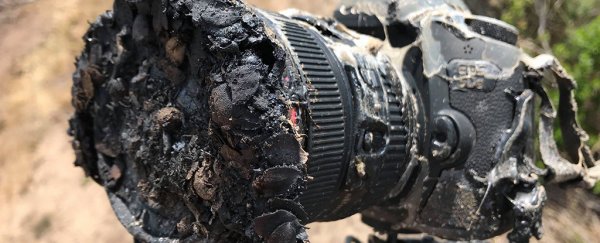If you're shooting photos of a space rocket launch, the risk to damage equipment is all too real, as one NASA photographer demonstrated this week.
Exhibit A is the melted Canon 5DS DSLR camera you can see in the picture above, by Bill Ingalls. The device, which was set up remotely, was scorched beyond repair at this week's SpaceX Falcon 9 rocket launch, but not before it had captured a couple of snaps.
Ingalls is an experienced space launch photographer, and it wasn't rocket fuel that turned the Canon camera to goo, but rather the heat of a brush fire that was caused by the burn of the rocket fuel… so there was a stroke of bad luck there.
Surprisingly, some of the shots captured before the camera's fiery demise survived, such as this amazing scene of the take-off of the SpaceX Falcon 9.
 (NASA/Bill Ingalls)
(NASA/Bill Ingalls)
"Well, one remote cam outside the pad perimeter was found to be a bit toast(y)," wrote Ingalls on Facebook, with an obligatory sad face emoji.
"This was [the] result of a small brush fire, which is not unheard of from launches, and was extinguished by firemen, albeit, after my cam was baked."
Ingalls was at the Vandenberg Air Force Base in California in his role as senior photographer for NASA Headquarters, watching the Falcon 9 rocket take up various payloads into orbit.
Those payloads included two GRACE-FO satellites from NASA, built to track changing water levels on Earth, as well as five Iridium NEXT satellites intended to bolster the telecommunications systems we all rely on.
The pair of Gravity Recovery and Climate Experiment Follow-On satellites are particularly interesting. They're tasked with measuring the ebb and flow of fresh water on our planet, and through that working out the amount of water in the oceans, lakes, rivers, soil, and glaciers – all useful information as we tackle the challenge of climate change.
We're pleased to report that the launch went off without a hitch – it just cost Bill Ingalls a camera, thanks to that brush fire. Here's the last glimpse the Canon had of the world:
 (NASA/Bill Ingalls)
(NASA/Bill Ingalls)
Ingalls actually had four other remote cameras closer to the launch pad, all of which came out unscathed. It's the first camera he has lost during a launch, even though he's been snapping them since 1989, he told Tariq Malik at Space.com.
According to Ingalls, the biggest risk to a camera at a rocket launch is not actually flames but debris: pushing a rocket out into space can kick up a lot of rocks and stones that can fly out at high speeds and damage any cameras in the vicinity.
And when you're paying several thousand dollars for the camera – the price bracket the Canon 5DS DSLR is in – you want to minimise risks as much as possible.
We're sure the occasional brush with fire hasn't dampened Ingalls's enthusiasm for the enviable job of being NASA's chief photographer.
"We're always trying to find creative new angles on [launches] and to explore what possibilities there are to make some unique imagery," he told Space Answers in 2014.
